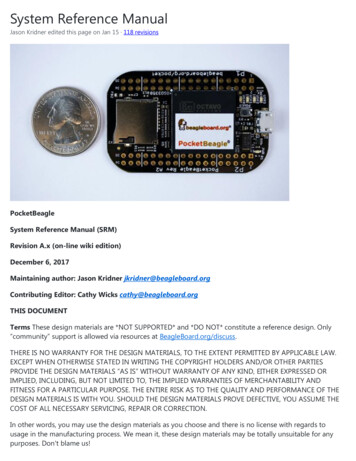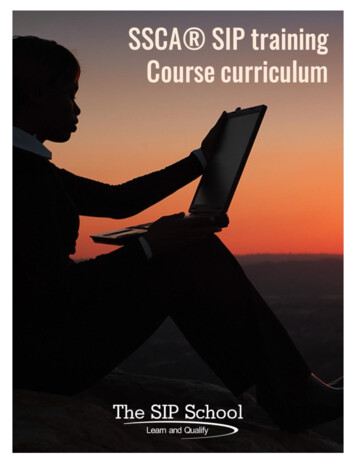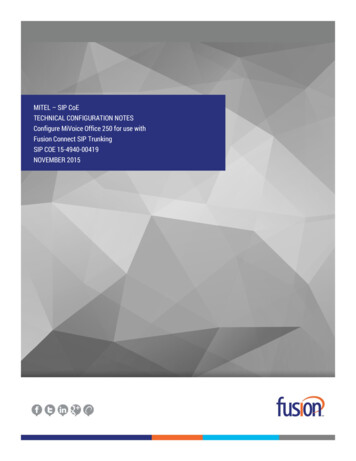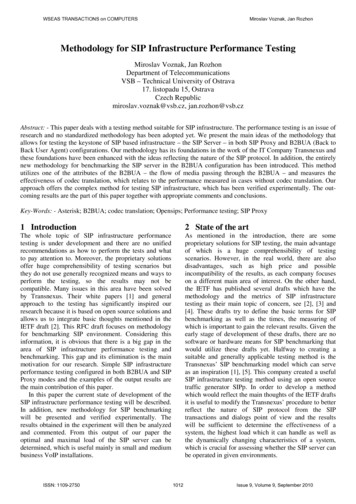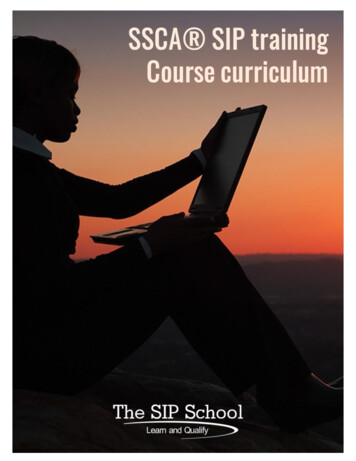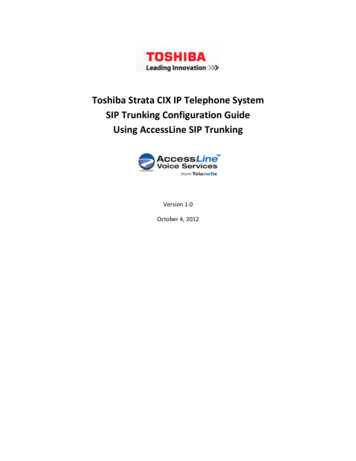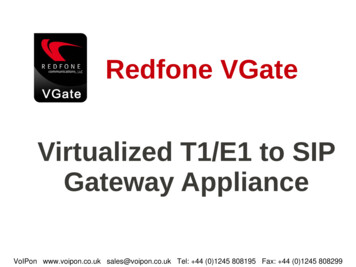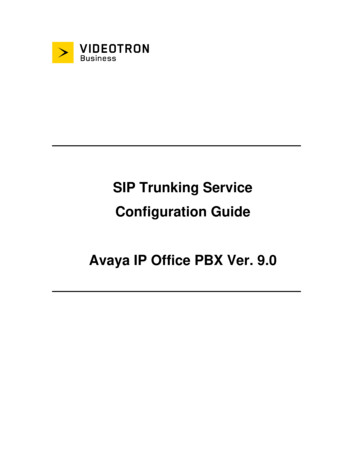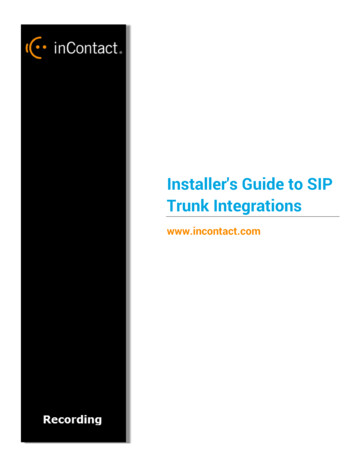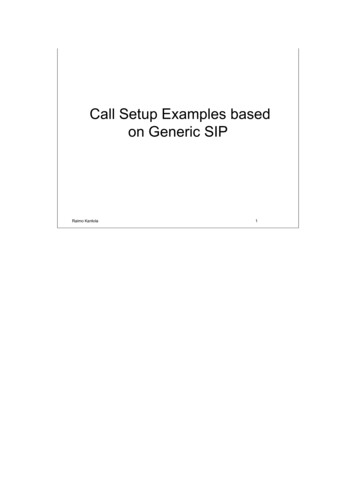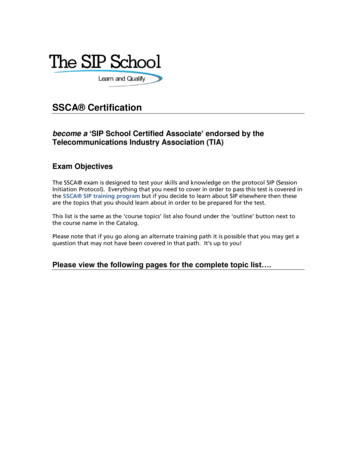
Transcription
SSCA Certificationbecome a ‘SIP School Certified Associate’ endorsed by theTelecommunications Industry Association (TIA)Exam ObjectivesThe SSCA exam is designed to test your skills and knowledge on the protocol SIP (SessionInitiation Protocol). Everything that you need to cover in order to pass this test is covered inthe SSCA SIP training program but if you decide to learn about SIP elsewhere then theseare the topics that you should learn about in order to be prepared for the test.This list is the same as the ‘course topics’ list also found under the ‘outline’ button next tothe course name in the Catalog.Please note that if you go along an alternate training path it is possible that you may get aquestion that may not have been covered in that path. It’s up to you!Please view the following pages for the complete topic list .
Core SIPTopics:SIP – Who BenefitsSIP – The Session Initiation ProtocolSIP ‘Official Summary’Based on HTMLWhere does SIP fit in?SIP Clients and ServersSIP User AgentsSimple Call Session SetupSIP System ArchitectureThe URI - Unique Resource IdentifierSIP AddressingSIP Addressing ExamplesSIP Servers and OperationRegistrationRe-RegistrationSIP Proxy servers and why we need themSIP Server – Proxy ModeSIP Server – Re-Direct ModeProxy Server ‘State’ typesLocation ServicesRegistrationRe-RegistrationDHCP and SIPSIP Proxy – Trapezoid ModelSIP Server in Proxy ModeSIP Server in Proxy Redirect ModeStateful and Stateless ProxiesLocation ServerLocation Server – ComponentsLocation Server – Information SourcesLocation Server – ExampleSIP MessagingRequest MethodsResponse CodesSIP HeadersINVITE – ExampleRESPONSE – ExampleSIP Request MethodsSIP Response CodesSIP HeadersSIP HEADER - INVITESIP HEADER - 200 ResponseSDP – the Session Description ProtocolSDP – The Session Description ProtocolSDP in a SIP MessageAn SDP ExampleExtending SDPChanging Session ParametersCall Hold exampleMultiple ‘m’ linesSDP – The Session Description ProtocolSDP Component in a SIP MessageSDP ExampleExtending SDPChanging Session ParametersSDP Example - Put a call on HoldSDP Example - Call Hold Trace
Call Hold – Old and New MethodsMusic on Hold exampleINVITE and reINVITESIP MobilitySIP MobilitySIP Call Forking - ParallelSIP Call Forking - SequentialCall legs, dialogs and Call IDsDialog trace exampleDialogs and TransactionsBranch IdsCall Forward - No AnswerCall Forward to VoicemailMore on Proxies and SIP RoutingStateless ProxyStateful ProxyMore Proxy informationVIA and Record RouteVIA DetailsRecord-Route DefinedRecord Route ExampleSession PoliciesMIMEMIMEMultiple MIME partsSIP and the PSTNSIP and the PSTNSIP to PSTN Call FlowSIP to PSTN DetailSIP Codes and the PSTNSIP and B2BUAB2BUA - Back to Back User AgentB2BUA ExampleB2BUA Benefits and FeaturesSIP SummaryRequest for CommentsNew RFCsSIPITThe Call Process
WiresharkTopics:WiresharkWhat is Wireshark?Your Initial SetupSIP account with Voipuser.orgX-lite client for testingConfigure X-LiteDownload WiresharkWireshark – Basic LayoutWireshark iconsUsing Wireshark – CapturingUsing Wireshark – Simple FiltersUsing Wireshark – More SIP statisticsUsing Wireshark – RTP StatisticsSaving CapturesOver to you!What are the codes?Link to Troubleshooting module for Advanced Wireshark
SIP-T and the PSTNTopics:SIP-T and the PSTNSIP to PSTN OverviewSIP to PSTN Call FlowSIP to PSTN DetailPSTN to SIP Call FlowSIP to PSTN Call FailureSIP to PSTN Call traceEarly MediaEarly Media - SIP to PSTN CallEarly Offer and Delayed OfferEarly Offer / Delayed OfferGatewaysDefault Gateway?Gateway Location and Routing with TRIPTRIP ExamplesSIP-T and PSTN BridgingSIP-TSS7, ISDN and SIPISUP and SIP MessagesISDN User Part (ISUP) to SIP CodesPSTN to PSTN via SIPISUP EncapsulationISUP Encapsulation / SDPAddressing NotesSIP and DTMFDTMF - Quick Re-CapWhat is DTMF?DTMF Transport methodsDTMF ‘Inband’RFC 2833 ‘Trace’ exampleRFC 4733 replaces 2833SIP INFO ‘Trace’ example
SIP, VoIP and QoSTopics:What is VoIP or Voice over IP?What is VoIP?What is Voice over IP?VoIP – ‘A Basic Call’VoIP and TCP / UDPVoIP over the InternetBranch to Branch VoIPIP PBXVoice Sampling and CodecEncodingCodecs for VoiceTry the Codec TestHigh Definition (HD) VoiceSound testsWideband (HD) codecsMOS – Mean Opinion scoresThe Real time Protocol or RTPRTP EncapsulationRTP Header TraceReal Time Control ProtocolRTCP-XR (Extended Reports)RTP / RTCP and UDP PortsQuality of ServiceQoS IssuesMeasuring DelayJitter and Packet LossGeneral VoIP Acceptance CriteriaQoS on the Network802.1Q – VLANs802.1Q/P Tagging802.1P - L2 ClassificationTOS and DiffServeLayer 3 ClassificationCodecs and BandwidthSymmetric DSL (SDSL)Testing your linkSIP, SDP and VoIPSIP in the TCP/IP ModelSIP and SDP MessagesSIP and SDP Codec mappingWhere does SIP fit in?SIP, SDP and VoIP INVITEAudio and Video in the SDP body
SIP SecurityTopics:Authentication and AuthorizationSIP Proxy Authentication401 and 407 AuthorizationSIP AuthorizationPROXY AuthenticationSSL with MD5 Cracked!MD5 v SHAEncryptionWhy Encrypt SIP?Certificates and HTTPSCertificate AuthoritiesCertificate ExampleSelf-Signed CertificatesFormat typeSecuring SIP and VoIPSSL and TLSSIP and TLSTLS ThoughtsTLS and SIP in ActionSIPS and SIP AddressingSecure RTP (SRTP)Setting SRTP on SIP DevicesSecure RTP (SRTP) - ExampleSRTP and SRTCPsdes and the Crypto attributeCrypto attribute exampleCrypto multiple streamsRFC 4474 for Caller IdentityCaller IdentityDTLS/SRTPS/MIME and SIPMIME and ISUPSIP Trunking and SecurityEnhancing SIP Trunk SecurityAlternatives - IPSec, ZRTPAttacks and ResponsesTypes of Attack on a VoIP/SIP NetworkResponses and ProtectionTLS v SSLResponse Identity – A Problem!Rogue SIP ProxyPhishing and SIP exploitMore Examples RFC 4475Try for yourself with recommended software toolsNIST RecommendationsNIST Recommendations on securing VoIP
Firewalls, NAT and Session Border ControllersTopics:OverviewIssues to addressFirewallsWhat does a Firewall do?Are Firewalls effective?NAT or Network Address TranslationWhat is NAT?NAT RequestNAT ResponseMultiple NATsThe NAT ProblemTypes of NATTypes of NATNAT – Full ConeNAT – Restricted ConeNAT – Port Restricted ConeNAT – SymmetricThe NAPT or (PAT) ProblemProblems with NAT, Firewalls and SIPThe SolutionsSTUN (Simple Traversal of UDP)STUN (Simple Traversal of UDP)STUN and rportProblems with STUNTURN (Traversal Using Relay NAT)Interactive Connectivity Establishment (ICE)How ICE works – Simplified!More on ICEUniversal Plug and Play (UPnP)The RTP ProblemThe Firewall ProblemSolving the RTP ProblemSymmetric RTPMedia ProxyApplication Level GatewaySIP Aware Firewalls - IncomingSIP Aware Firewalls - OutgoingSession Border ControllersSBC for the EnterpriseSBC for the ITSPRecommended Session Border Controller featuresSBCs in Action!
SIP TrunkingTopics:SIP TrunksWhat is a SIP TrunkAlternative to TDMSeparate Data and Voice connectionsConverging the networkSIP Trunks and CodecSIP Trunk BenefitsSIP Trunking – In More DepthSIP Trunk CapabilitiesSIP Trunking Network ExamplesSIP PeeringPeering problems?Least Cost routing (LCR)Disaster RecoveryDisaster Recovery ‘Expanded detail’Disaster Recovery – Last resort?Trunking VariationsSingle Site, TDM PBXSingle Site, No ‘Forklift’Single Site, ConvergedConverged – SIP/IP PBXMultiple Site, ‘Converged’Media GatewaysSIP PBX to Non-SIP PBXSIP PBX to Non-SIP PBX, Call FlowSIP Trunk PerformanceThe ADSL issueCodecs, Voice and DataSymmetric DSL (SDSL)Bandwidth CalculatorTesting your linkSIP Trunking and MPLSMPLS, basic explanationYour own VPLSbut ‘Not the only client’Separate MPLS networksSecurity and SIP TrunkingSIP Trunk Security - OverviewSession Border ControllersSetting up a SIP TrunkAdd a VoIP ProviderProvider SIP ServersAuthenticationStun and the Firewall testAdd a Dialling RuleTrunk setup completeRegistration TraceCall out TraceSome PBX RequirementsEnterprise PSTN IdentitiesP-Preferred and P-AssertedCall Progress Tones
Next Generation NetworksWhat are NGNs?An Example – British TelecomTroubleshooting and InteropsSIP Trunks and Common ProblemsThe SIP ForumSIPitsSIPit ResultsSIP Connect DocumentSIP Connect ‘Missing pieces’SIP Connect 1.1Choosing an ITSPUnderstanding ITSP OfferingsResource WebsitesTMCnet – Sip trunkingSiptrunk.orgNo Jitter - Hotzone
Testing, Troubleshooting and InteroperabilitySetting up your test environmentUsing SIP IP PhonesUsing SIP SoftphonesEven more SIP SoftphonesSIP CommunicatorChoosing a ‘Trial/Test’ ITSPGetting Free ITSP AccountsConfiguring your SoftphoneGet a SIP URI of your ownSIP2SIP accountsConfiguring SIP Communicator with a SIP2SIP accountUsing ‘Test Numbers’Multiple Setup options for you to tryConfigure X-Lite and SIP Communicator on the same PC for testingExample - The SIP Phones @ The SIP School WiresharkLoading WiresharkNetwork interface setup for captureWireshark - Basic LayoutUnderstanding Wireshark IconsUsing Wireshark - CapturingUsing Wireshark – Simple FiltersUsing Wireshark – SIP StatisticsSaving CapturesWireshark in more depth!SIP StatisticsRTP / VoIP Capture and PlaybackMore ‘SIP ladder’ analysisColoring rulesMore ‘filter expressions’More Help on Wireshark if you need itYou tryWhere to Capture?Interoperability TestingInterop TestingWhy Interop can be toughDifferent interpretations in the RFC 3261BLISS – Basic Interoperability for SIP ServicesInterop Test ScenarioInterop Test operationsSample Interop TracesWireshark example videos to help understand interop issuesSIPIT eventsCommon SIP problemsWill it ever work?What else can you do?Common SIP/VoIP ProblemsTroubleshooting SIP Trunks4xx — Client Failure Responses5xx — Server Failure Responses6xx — Global Failure ResponsesMore SIP Testing ToolsSIP ScenarioSIP WorkbenchSIP Monitoring example appSIP ScanTestYourVoIP.comHoverIP
NSLookupSIP Center and Voip-info for more tools!Using the NET to find answersThe SIP Wiki
ENUM and DNSTopics:ENUM ExplainedWhat is E.164?What is ENUM?Why ENUM?Call Routing and ENUM - ExampleEnum, DNS and DomainsWhy are we using DNS?DNS and the WebThe e164.arpa DomainApproved ENUM DelegationsTIERS 0, 1, 2 and 3TIERS and RegistrarsDNS and AORe164.arpa Domain in actionExample - ENUM in the UKAddress of RecordReseaux IP EuropeensPSTN to SIP UA - ExampleThe ENUM QueryNAPTR RecordsDNS Response to an ENUM queryCalls FlowsPSTN to SIP UA – Example (2)IP to PSTN (Simplified)MARTINITypes of ENUMDifferent ‘Types’ of ENUMThe Problems with ‘Public’ ENUMExample – ‘Private’ ENUMExample – ‘Operator’ ENUMStay ‘On-NetFrom ITSP to PSTN and Back !Peering Profiles and AgreementsA few providersViPRVerification Involving PSTN Reachability (ViPR).What is ViPRViPR and P2PInitial PSTN CallViPR Call RecordQuery the DHTDHT query and ValidationThe Next call is a SIP CallViPR SummaryTry for yourselfRegister your numberTesting ENUMENUM and the futureHow is ENUM moving forward?Useful Links
SIP and Unified CommunicationsTopics IncludeCommunication BreakdownPlaying Voicemail tagCan’t find peopleAvailable but not Available.!More Examples of communication problemsIM ClientsIM Client FeaturesEnterprise ClientsMore in IM ClientsIM and Mobile devicesThe Background StuffThe IMPP working groupIMPP and CPPMore IMPP workSIMPLEHow it all worksPresentityA Basic SIP subscriptionMultiple Presence StatesPresence and P2PA Presence NetworkGetting inside the SIP packetsPresentity and more!A Basic SIP SubscriptionMultiple Presence StatesPresence and P2PA Presence NetworkGet inside the SIP packetsThe Packet StructurePIDF Message BodyXMLTuplesExample Presence doc with Tuples (using a Mobile Phone)Rich PresenceThe METHODS in ActionPUBLISH STATEPUBLISH and PIDF/XML bodySUBSCRIBE METHOD202 OK ResponseNOTIFYMESSAGEAdd A Buddy/Subscribeis-composingAlternative ‘Presence States’2 Places at the same timeConferencingWhat SIP does in ConferencingINITIATE a conferenceJOIN a conferenceLEAVE / EXIT a conferenceINVITE other participantsREFER conference server to invite or others to joinEXPEL participantsCONFIGURE the media streamCONTROL a conferenceWhy SIP?
Centralized conferencingCentralized SignalingCentralized Mixing (optional)Centralized AuthenticationB2BUA (Discussed in core module)Conference ComponentsThe FocusMore than one FocusConference Setupiscomposing in ConferenceMESSAGE in conferenceBYE in conferenceAlternative INVITESDP BODY OF INVITEIETF work and ConferencingXMPP v SIMPLEWhat is XMPP?SIMPLE and/or XMPPGatewaysFederationsWhat is Federation?Multiple Presence sourcesSuper-AggregationInter-Domain FederationUnified CommunicationsWhat’s all the fuss?Unified ConfusionComponents involvedWhat should UC do?21st Century Dial toneThe Unified inboxUnified aware applicationsFind me – Follow meDevice awarenessUnified Comms for BusinessDo your HomeworkHumans and UCUC in a SIP networkUCI ForumThe UCI Forum - ChallengesUCI Forum goalsUCIF websiteRelevant RFCsRFCs Galore
Even more SIP Softphones SIP Communicator Choosing a 'Trial/Test' ITSP Getting Free ITSP Accounts Configuring your Softphone Get a SIP URI of your own SIP2SIP accounts Configuring SIP Communicator with a SIP2SIP account Using 'Test Numbers' Multiple Setup options for you to try
